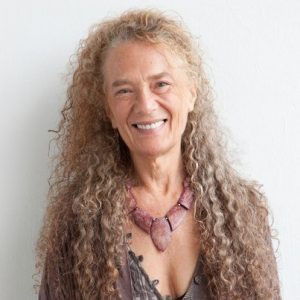Margaret Jenkins, the visionary founder of the San Francisco-based Margaret Jenkins Dance Company (MJDC), stands as a beacon in the dance world. A captivating performer, groundbreaking choreographer, and inspiring mentor, Jenkins’ influence extends far beyond the stage. Her journey began in New York City in the 1960s with studies at The Juilliard School, followed by further education at the University of California, Los Angeles (UCLA). Returning to New York, she graced the stages with renowned companies led by Jack Moore, Viola Farber, Judy Dunn, James Cunningham, Gus Solomons, Jr., and even Twyla Tharp’s original company alongside Sara Rudner.
 Margaret Jenkins
Margaret Jenkins
My first encounter with Jenkins was at the iconic Merce Cunningham Studio on Third Avenue. Our friendship blossomed when I sublet Sara Rudner’s apartment in New York’s “Little Italy,” our kitchens facing across a narrow space, becoming venues for countless conversations over steaming cups of Italian coffee. Beyond her performance career, Jenkins was a valued faculty member at the Merce Cunningham School and played a crucial role in preserving Cunningham’s legacy by restaging his works across Europe and the United States for twelve formative years. Notably, in 1967, when Cunningham first entrusted his choreography to another company, he chose Jenkins to restage Summerspace for the Cullberg Ballet in Stockholm, Sweden. Summerspace, a landmark piece, originally premiered on August 17, 1958, at the American Dance Festival, featuring a stellar cast including Carolyn Brown, Remy Charlip, Merce Cunningham himself, Viola Farber, Cynthia Stone, and Marilyn Wood, with costumes and set by Robert Rauschenberg and music by Morton Feldman.
Following my time with the Cunningham Company, Margy, as she is affectionately known by friends, and I co-founded the Viola Farber Dance Company in 1970. Her decision to return to her native San Francisco with her husband was a poignant moment for me, yet it proved to be a transformative move for the West Coast dance scene. It was no surprise to those of us in New York that Jenkins swiftly became a central figure, a driving force in shaping the San Francisco dance community.
In 1973, MJDC was officially established, and with it, Jenkins unveiled the Bryant Street Studio. This pioneering space was among the first studio-performing venues on the West Coast, simultaneously serving as a school dedicated to training professional modern dancers. Bryant Street Studio quickly became a vital hub, welcoming both local and touring companies to conduct master classes and present their work. Dance luminaries like Merce Cunningham and Viola Farber were frequent guests, alongside a multitude of other inspiring artists who found in this space a safe haven to experiment and push the boundaries of their choreographic visions. This early venture laid the groundwork for what would later become the celebrated Margaret Jenkins Dance Lab, solidifying Jenkins’ commitment to nurturing dance innovation and community.
 Margaret Jenkins, Twyla Tharp, Sara Rudner in
Margaret Jenkins, Twyla Tharp, Sara Rudner in
The company’s journey continued in 1980 with a move to a studio on 15th Street in San Francisco’s Mission District. Then, from 1983 to 1995, MJDC entered a significant partnership, sharing the beautiful New Performance Gallery with ODC/San Francisco. During this period, I had the privilege of teaching at the Gallery, and in 1989, collaborated with dance artist Douglas Nielsen to present a co-produced concert, 50/50.
After the partnership with ODC/San Francisco evolved, MJDC embarked on an ambitious four-year project: transforming a large gymnasium on the UC San Francisco campus into a dedicated performance and rehearsal space. This endeavor culminated in 2004 with the opening of the Margaret Jenkins Dance Lab, marking a pivotal moment as it became the company’s permanent home and a crucial center for dance innovation. The Dance Lab was more than just a studio; it was envisioned as a crucible for creativity, a space where dancers, choreographers, and audiences could converge to explore and celebrate the art of movement.
Since the inception of MJDC, Jenkins has choreographed over 80 works for her company and for companies across the United States, Asia, and Europe. Her choreographic talent has been sought after by numerous college and university dance departments, and she has received prestigious commissions from leading presenters including the Clarice Smith Center for the Performing Arts at the University of Maryland, Yerba Buena Center for the Arts (YBCA), The Dance Center of Columbia College in Chicago, National Dance Project (NDP), Krannert Center for the Performing Arts, Arizona State University, and Ginko, a modern dance company in Tokyo, Japan. In 2008, Jenkins achieved another milestone, being one of only two women honored with the opportunity to create a new work for the San Francisco Ballet’s 75th anniversary. This prolific output underscores her enduring influence and contribution to the contemporary dance landscape, with The Dance Lab serving as a central incubator for many of these groundbreaking projects.
 Merce MJ and Birgit Cullberg 1967 copy
Merce MJ and Birgit Cullberg 1967 copy Rinde Eckert, Margaret Jenkins in Shadows and Water Photo by Kegan Marling
Rinde Eckert, Margaret Jenkins in Shadows and Water Photo by Kegan Marling Rinde Eckert, Margaret Jenkins in Shorebirds Atlantic
Rinde Eckert, Margaret Jenkins in Shorebirds Atlantic TRACE FIGURES copy
TRACE FIGURES copy Trace Figures MJDC 2019
Trace Figures MJDC 2019
Jenkins’ remarkable career has been recognized with numerous accolades, including a Guggenheim Fellowship, an Irvine Fellowship in Dance, the San Francisco Arts Commission Award of Honor, three Isadora Duncan Awards (Izzies), culminating in a Sustained Achievement Award in 2015, and the Bernard Osher Cultural Award for her exceptional contributions to the arts community in San Francisco and the Bay Area. Adding to these honors, April 24, 2003, was officially declared “Margaret Jenkins Day” in San Francisco by Mayor Willie Brown, following a Governor’s Commendation from Governor Gray Davis on the same day. These awards are a testament to her profound impact and the high esteem in which she is held within the arts community and beyond.
Jenkins’ commitment to the dance community extends beyond her own company and choreography through the founding of CHIME (Choreographers in Mentorship Exchange) and Encounters Over 60, two impactful community-based dance projects that were significantly fostered within The Dance Lab. CHIME, established by Jenkins in 2004, is a professional mentorship program designed to foster crucial dialogue between established and emerging choreographers and movement-based artists. Jenkins recognized the vital importance of intergenerational exchange for the vitality of the dance field, aiming to “create an arena for the rigorous, critical analysis of choreography, stimulating the artistic growth and confidence of emerging choreographers.” Over its lifespan, CHIME has provided substantial, direct support to over 150 choreographers through mentoring, free rehearsal space at The Dance Lab, workshops led by guest artists, and public showings of their works. Encounters Over 60 is another significant program hosted at The Dance Lab, focused on increasing the visibility and providing support for elder dance artists through two-week residencies, further solidifying The Dance Lab’s role as a community anchor.
It was with profound sadness that I learned of the closure of the Margaret Jenkins Dance Lab. After fifteen years as a vibrant hub of innovative and creative activity, The Dance Lab became another casualty of the pandemic closures. Knowing firsthand the incredible history Margy and I share, and recognizing the immense impact she and her company have had on art communities in San Francisco, Israel, China, India, and globally, this news was particularly disheartening.
 Margaret Jenkins Dance Lab – Photo courtesy of MJDC
Margaret Jenkins Dance Lab – Photo courtesy of MJDC
In a press release dated September 25, 2020, MJDC poignantly announced:
“Our summer, like for many, has been a mix of saying goodbye to old structures and opening ourselves up to new ways of moving forward with resilience, hope and tenacity…awaiting embrace.
“The Margaret Jenkins Dance Lab was a place to gather, to generate, to share one’s discoveries, innovations, and investigations. It was a place for transmission of ideas across race and age and a diversity of styles in our mentorship program CHIME (Choreographers in Mentorship Exchange) and most recently Encounters Over 60. The Dance Lab was a hub of activity that greeted everyone equally and we looked forward to it flourishing.
“As the pandemic took hold across the world, important measures like social distancing and the sustained shelter-in-place came into effect, imploring us to close our doors to the community. Our board and staff explored every option, but in this environment there was no way to sustain our community space. With the understanding of our funders and our community, and after 15 years of movement and light held within the walls and floor, we said goodbye to the Margaret Jenkins Dance Lab.”
Despite the closure of The Dance Lab, MJDC’s community programs are thankfully continuing. With the support of the Hellman Foundation and the Fleishhack Foundations, its 2021 programs are under development, providing much-needed encouragement to sustain CHIME and Encounters Over 60. Furthermore, amidst the farewell to The Dance Lab, MJDC and ten other dance artists received a Hewlett 50 Arts Commission, one of the nation’s largest commissioning initiatives. This prestigious award was granted to MJDC for Global Moves, a new work in collaboration with artists from China, India, and Israel – countries where Jenkins has been creating works since 2006. This resilience and forward momentum are critical for the company’s future.
 Margaret Jenkins Dance Lab – Photo courtesy of MJDC
Margaret Jenkins Dance Lab – Photo courtesy of MJDC
Global Moves will bring together dancers from companies in these three countries for the first time, in partnership with MJDC’s long-term collaborators Paul Dresher, Alexander V. Nichols, Michael Palmer, Rinde Eckert, and Mary Domenico. The work is envisioned to address themes of xenophobia and nationalism, alongside the social and health pandemics, capturing the pervasive sense of isolation, frustration, and fury of our current times. Global Moves is slated to premiere in the fall of 2021, showcasing MJDC’s ongoing commitment to artistic innovation and global dialogue even in the face of challenges.
The Margaret Jenkins Dance Lab’s closure is a stark reminder of the widespread impact of the COVID-19 pandemic on the dance community, joining a growing list of studios that have been forced to close their doors. The full extent of the pandemic’s consequences on the national and global dance landscape will only become clear in the years to come. However, the spirit of resilience and innovation within the dance world persists.
In a recent interview with Lou Fancher of the San Francisco Classical Voice, Ms. Jenkins was asked about her hope for the arts community in the face of these multiple challenges. Her response echoed the Margy I have known for over forty years: “The resilience and determination of artists who believe art is a form of resistance, the young people in their 20s, 30s, and 40s is extraordinary and constantly fuels my ability to get up and keep going. Those generations fuel people in their 50s, 60s, and 70s, and we support one another in a way that is rather poignant and breathtaking at times. We are incredibly privileged being in this world of newly realized/extraordinary activism.” This enduring optimism and dedication are hallmarks of Margaret Jenkins’ character and her unwavering belief in the power of art and community.
To further explore the work of Margaret Jenkins and her company, please visit the Margaret Jenkins Dance Company website HERE.
Written by Jeff Slayton for LA Dance Chronicle.
Featured image: Elizabeth Streb seated in chair center – Margaret Jenkins Dance Lab – Photo courtesy of MJDC

